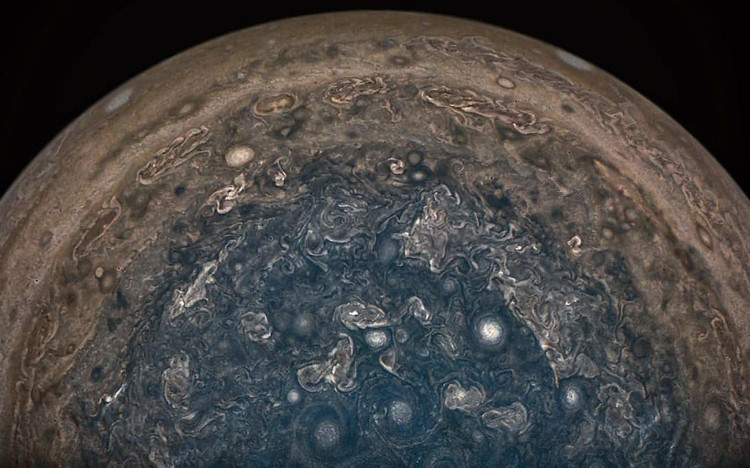NASA published a detailed photograph of Jupiter's southernmost surface sent by Juno
NASA has just released a picture of Jupiter's southernmost surface, recorded by Juno. The Juno probe has approached Jupiter since August 2016 and has begun its mission to explore the planet ever since. The southernmost picture of Jupiter was recorded on February 2, 2017 and sent back to Earth, NASA released these data for those interested and a civilian scientist who postponed this photo to them. I see.
Juno's photograph captured Jupiter's surface from 101 thousand kilometers above the highest level of Jupiter's atmosphere. The Juno probe continues its mission and is expected to send more precious image data to Earth. Currently the Juno flight trajectory around Jupiter only takes 14 days. The ship will be self-propelled until February 2018 before being ordered to fall into Jupiter's atmosphere and destroy itself.

The southernmost shot of Jupiter.
The Juno probe was launched by NASA to Jupiter to study the largest solar system star to find out how it works. It takes 5 years to fly over 2.7 billion km, Juno can reach Jupiter. On Juno equipped with many sensors, it will observe the giant planet through many layers and measure its composition, temperature, motion and other properties. Images and data sent to Earth will help experts discover whether Jupiter has a solid core or just a compressed gas in the densest state of the planet.
The largest planet in the solar system, Jupiter is a giant gas sphere with a diameter 11 times larger and 300 times heavier than the globe. Researchers identify it as the first planet to form in the solar system and clue the evolutionary clues of the solar system.
By studying the structure beneath Jupiter's surface, the Juno ship will help humans decipher the mysteries of the planet. Juno will fly around Jupiter's poles to avoid the most dangerous radiation belts emitted by the planet. The spacecraft possesses a special component to prevent radiation from jeopardizing important equipment. It is expected to complete the mission in February next year.
- A series of wonderful images of Jupiter are sent from the Juno-NASA ship
- NASA discovered deep holes on Mars
- NASA's billion-dollar probe began to fall freely into Jupiter
- The Juno ship first approached Jupiter since flying into orbit
- NASA prepares a new mission to Jupiter
- NASA's Juno spacecraft is about to approach Jupiter on July 4
- NASA ships eclipse photos of Jupiter
- The jagged surface of Pluto
- Detailed 3D map of the Moon's surface
- Juno spacecraft completes halfway to Jupiter
- Juno Jupiter probe flies close to Earth
- Shocking sign of the apocalypse in a photo of NASA just released
 Van Allen's belt and evidence that the Apollo 11 mission to the Moon was myth
Van Allen's belt and evidence that the Apollo 11 mission to the Moon was myth The levels of civilization in the universe (Kardashev scale)
The levels of civilization in the universe (Kardashev scale) Today Mars, the sun and the Earth are aligned
Today Mars, the sun and the Earth are aligned The Amazon owner announced a secret plan to build a space base for thousands of people
The Amazon owner announced a secret plan to build a space base for thousands of people